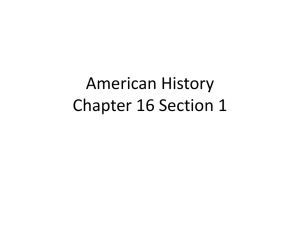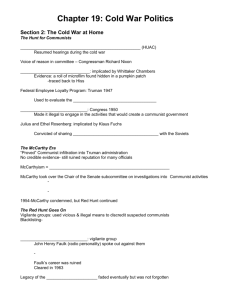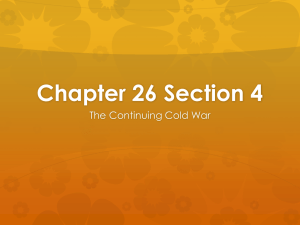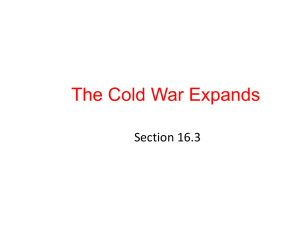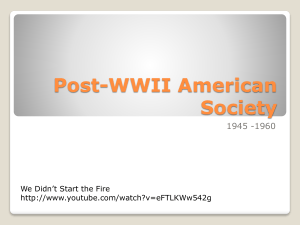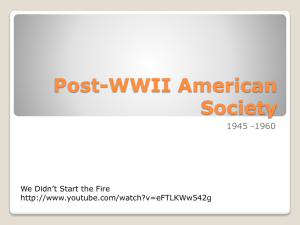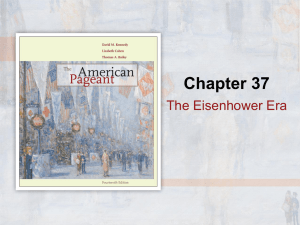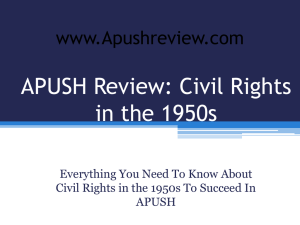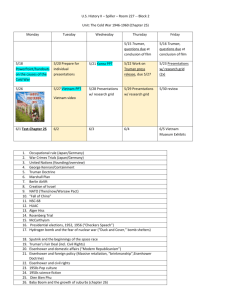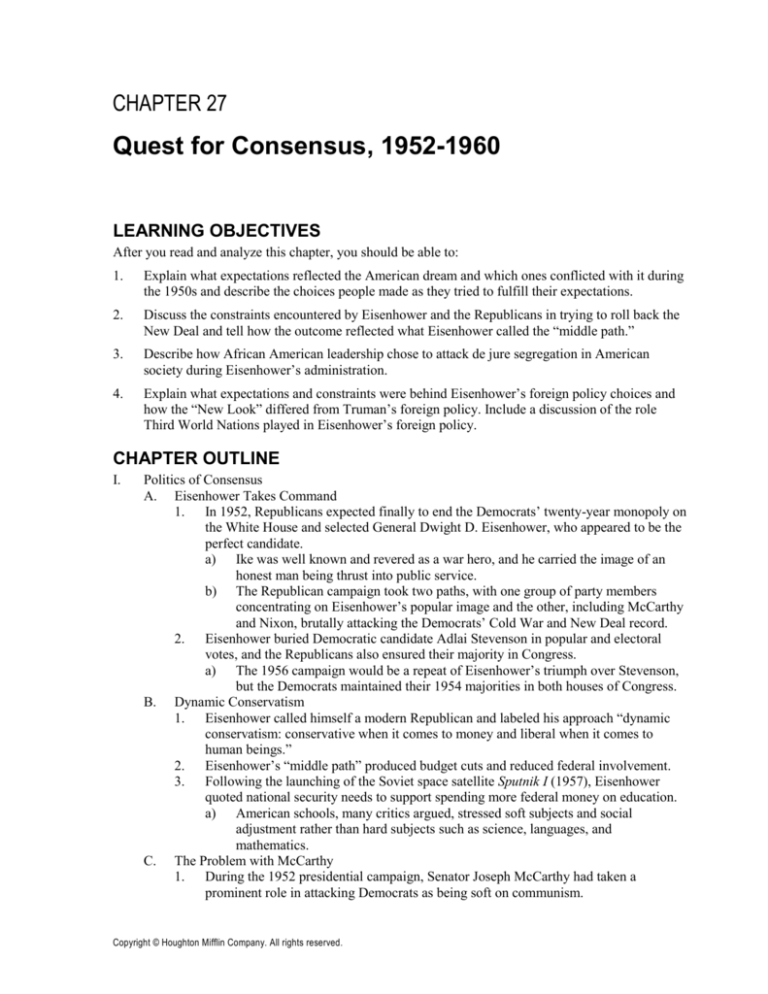
CHAPTER 27
Quest for Consensus, 1952-1960
LEARNING OBJECTIVES
After you read and analyze this chapter, you should be able to:
1.
Explain what expectations reflected the American dream and which ones conflicted with it during
the 1950s and describe the choices people made as they tried to fulfill their expectations.
2.
Discuss the constraints encountered by Eisenhower and the Republicans in trying to roll back the
New Deal and tell how the outcome reflected what Eisenhower called the “middle path.”
3.
Describe how African American leadership chose to attack de jure segregation in American
society during Eisenhower’s administration.
4.
Explain what expectations and constraints were behind Eisenhower’s foreign policy choices and
how the “New Look” differed from Truman’s foreign policy. Include a discussion of the role
Third World Nations played in Eisenhower’s foreign policy.
CHAPTER OUTLINE
I.
Politics of Consensus
A. Eisenhower Takes Command
1. In 1952, Republicans expected finally to end the Democrats’ twenty-year monopoly on
the White House and selected General Dwight D. Eisenhower, who appeared to be the
perfect candidate.
a) Ike was well known and revered as a war hero, and he carried the image of an
honest man being thrust into public service.
b) The Republican campaign took two paths, with one group of party members
concentrating on Eisenhower’s popular image and the other, including McCarthy
and Nixon, brutally attacking the Democrats’ Cold War and New Deal record.
2. Eisenhower buried Democratic candidate Adlai Stevenson in popular and electoral
votes, and the Republicans also ensured their majority in Congress.
a) The 1956 campaign would be a repeat of Eisenhower’s triumph over Stevenson,
but the Democrats maintained their 1954 majorities in both houses of Congress.
B. Dynamic Conservatism
1. Eisenhower called himself a modern Republican and labeled his approach “dynamic
conservatism: conservative when it comes to money and liberal when it comes to
human beings.”
2. Eisenhower’s “middle path” produced budget cuts and reduced federal involvement.
3. Following the launching of the Soviet space satellite Sputnik I (1957), Eisenhower
quoted national security needs to support spending more federal money on education.
a) American schools, many critics argued, stressed soft subjects and social
adjustment rather than hard subjects such as science, languages, and
mathematics.
C. The Problem with McCarthy
1. During the 1952 presidential campaign, Senator Joseph McCarthy had taken a
prominent role in attacking Democrats as being soft on communism.
Copyright © Houghton Mifflin Company. All rights reserved.
344
Chapter 27: Quest for Consensus, 1952-1960
a)
II.
With Ike in the White House and Republicans controlling Congress, many
Republicans hoped that McCarthy would quietly disappear.
2. Charging that he was trying to blackmail the U.S. Army, the Senate investigated
McCarthy and voted 67 to 22 to censure McCarthy’s “unbecoming conduct.”
Eisenhower and a Hostile World
A. The New Look
1. This foreign policy relied on cheaper nuclear deterrence, an enhanced arsenal of
nuclear weapons and delivery systems, and the threat of massive retaliation to protect
American national interests.
a) This policy drew the label of brinkmanship because it required the administration
to take the nation to the verge of war and trust that the opposition would back
down.
b) To make the idea of “going nuclear” and the possibility of World War III less
frightening, the administration introduced efforts related to surviving atomic war
such as fallout shelters.
c) Seeking ways to avoid a nuclear solution to international problems, Eisenhower
and Dulles emphasized alliances and covert operations.
2. To prevent social change in developing countries from “coming out red,” Eisenhower
relied on economic and political pressures and the Central Intelligence Agency.
B. Turmoil in the Middle East
1. Eisenhower was especially concerned about the Middle East, where Arab nationalism
fired by anti-Israeli and anti-Western attitudes posed a serious threat to American
interests.
a) Egypt and Iran offered the greatest challenges, and the CIA helped overthrow the
Iranian government when it appeared to be “seeing red.”
2. The Eisenhower Doctrine provided $200 million in military and economic aid to
improve military defenses in the nations of the Middle East.
C. A Protective Neighbor
1. Eisenhower offered anti-Communist Latin American governments—including
dictatorships—economic, political, and military support.
a) He was most concerned about Guatemala and eventually used the CIA to remove
Jocobo Arbenz and replace him with CIA-supplied Carlos Castillo Annas in
1954.
2. As Nixon toured Latin America, Cuban leader Fulgencio Batista was warding off a
rebellion led by Fidel Castro.
a) Castro triumphed, but many of his economic and social reforms seemed to
endanger American investments and interests, and the administration began
planning his overthrow.
D. The New Look in Asia
1. The Geneva Agreement “temporarily” partitioned Vietnam along the 17th parallel and
created the neutral states of Cambodia and Laos.
a) The two Vietnams were to hold elections to unify the nation within two years.
b) Neither was to enter into military alliances or allow foreign bases on their
territory.
E. The Soviets and Cold War Politics
1. Eisenhower feared and opposed the spread of Communist influence throughout the
world but realized that deterrence was only one tactic to limit Soviet power and avoid
nuclear confrontation.
a) A second way to improve Soviet-American relations was to reduce the expanding
arms race and limit points of conflict.
Copyright © Houghton Mifflin Company. All rights reserved.
Chapter 27: Quest for Consensus, 1952-1960
2.
345
After the Soviet takeover of Hungary in 1956, however, the spirit of cooperation
between the two superpowers faded.
3. On May 1, 1960, an American U-2 spy plane was shot down over the Soviet Union,
and its pilot was captured.
a) Eisenhower took full responsibility but refused to apologize.
b) Khrushchev withdrew from the Five Power Summit, and Eisenhower canceled
his trip to the Soviet Union.
4. In 1960, turning the Republicans’ own tactics of 1952 against them, Democrats
cheerfully accused their opponents of endangering the United States by being too soft
on communism.
III. The Best of Times
A. Web of Prosperity
1. The nation’s “easy street” was a product of big government, big business, cheap
energy, and an expanding population.
2. Technological advances also increased profits and productivity.
3. The growth of the service sector also characterized the workforce.
a) By 1956, white-collar workers outnumbered blue-collar workers for the first
time.
B. Suburban and Family Culture
1. People wanted to live in suburbs.
a) The brand-new developments represented a fresh start, a commitment to
community, the American dream, and an increasingly “classless” society.
2. Religious leaders were rated as the most important members of society, and no leaders
were more esteemed than the Reverends Billy Graham and Norman Vincent Peale and
Catholic bishop Fulton J. Sheen.
3. After the disruptions of depression and war, family took on a renewed importance: the
divorce rate slowed, and the number of marriages and births climbed as the baby boom
continued.
a) The home was the center of “togetherness” and was reinforced by the portrayal of
happy families in popular television shows.
b) Reality, however, rarely matched television’s images.
C. Consumerism
1. Another dimension of suburbia was consumerism.
2. The automobile industry benefited from and contributed to the development of both
roads and suburbs.
a) By 1960, 75 percent of Americans had at least one car, which increased the
pressure on governments and businesses to consider the needs of automobile
owners.
b) Stores had to include parking lots and easy access to roads and highways as part
of their planning, and new industries arose to service the needs of automobile
owners.
3. The suburban market was a result of expanding purchasing power made possible by
higher wages and readily expanding credit.
a) The Diner’s Club credit card made its debut, and American Express soon
followed.
b) Credit purchases leaped from $8.4 billion in 1946 to over $44 billion in 1958.
D. Another View of Suburbia
1. Unlike the wives shown on television, more and more women were working, many
even though they had young children.
2. Not all homemakers were happy, and men also showed signs of being less than
satisfied with the popular role of suburban dad.
Copyright © Houghton Mifflin Company. All rights reserved.
346
Chapter 27: Quest for Consensus, 1952-1960
E.
Rejecting Consensus
1. Sociologist David Riesman argued in The Lonely Crowd that postwar Americans were
“outer-directed” and less sure of their values and morals, and William Whyte’s
Organization Man discussed the same lack of individuality and independence.
a) Both authors urged readers to resist being packaged like cake mixes and reassert
their individuality.
b) Serious literature also highlighted a sense of alienation from the conformist
society, as exemplified by Sylvia Plath’s The Bell Jar.
c) More extreme were the Beats, a group of often-controversial artists, poets, and
writers.
F. The Trouble with Kids
1. Juvenile delinquency was not new to American society, but in the 1950s some
perceived an alarming new style of delinquency among white, middle-class, suburban
teens.
a) One study of middle-class delinquency concluded that the automobile not only
allowed teens to escape adult controls but also provided a private lounge for
drinking and for petting or sex episodes.
2. The problem with kids also seemed wedded to rock ‘n’ roll music.
IV. Outside Suburbia
A. Integrating Schools
1. In 1954, the Supreme Court accepted NAACP lawyer Thurgood Marshall’s argument
that “separate but equal” was inherently unequal in Brown v. Board of Education,
Topeka, Kansas.
a) He stressed that segregated educational facilities, even if physically similar, could
never yield equal products.
b) This decision raised a loud cry of protest from white southerners, who vowed to
resist segregation by using all means possible, including violence.
2. While both political parties were carefully dancing around civil rights, blacks made it
increasingly difficult for politicians to avoid the issue.
a) Eisenhower was forced to face the issue in the effort to integrate Central High
School in Little Rock, Arkansas.
b) Ike nationalized the Arkansas National Guard and dispatched 1,000 troops to
uphold the law and restore order.
3. But, in many communities, meaningful integration was still years away as many white
students fled the integrated public schools to attend private ones that were beyond the
reach of federal courts.
B. The Montgomery Bus Boycott
1. In 1955, Rosa Parks refused to give up her seat on a bus so that a white man could sit
and was arrested.
a) African American community leaders, including Martin Luther King, Jr., called
for a boycott of the buses to begin on the day of her court appearance.
2. The boycott was 90 percent effective and stretched into days, weeks, and months.
a) Even in the face of personal attack and growing white hostility, King remained
calm, reminding supporters to avoid violence and maintain the boycott.
b) As the boycott approached its anniversary, Gayle et al. v. Browser stated that the
city’s and bus company’s policy of segregation was unconstitutional.
c) A pattern of nonviolent resistance had been initiated, and a new civil rights
organization, the Southern Christian Leadership Conference, was formed.
C. Ike and Civil Rights
1. Personally, Eisenhower believed that the government, especially the executive branch,
had little role in integration.
Copyright © Houghton Mifflin Company. All rights reserved.
Chapter 27: Quest for Consensus, 1952-1960
2.
347
The Civil Rights Act of 1957 provided for the formation of a Civil Rights Commission
and opened the possibility of using federal suits to ensure voter rights.
a) In 1960, Congress passed a voting rights act that mandated the use of the courts
to guarantee enforcement.
IDENTIFICATIONS
Identify the following items and explain the significance of each. While you should include any
relevant historical terms, using your own words to write these definitions will help you better remember
these items for your next exam.
1.
Ray Kroc
2.
consensus
3.
Dwight D. Eisenhower
4.
Adlai Stevenson
5.
“Checkers speech”
6.
dynamic conservatism
7.
Federal Highway Act
8.
Sputnik
9.
National Defense Student Loans
10. United States Information Agency
11. Army-McCarthy hearings
12. Korea
13. New Look
14. massive retaliation
15. brinkmanship
16. John Foster Dulles
17. demilitarized zone
18. fallout shelter
19. covert operation
20. bilateral
21. multilateral
22. Baghdad Pact
23. Central Intelligence Agency
24. Shah Mohammed Reza Pahlevi
25. pan-Arab movement
26. Eisenhower Doctrine
27. junta
28. Fidel Castro
Copyright © Houghton Mifflin Company. All rights reserved.
348
Chapter 27: Quest for Consensus, 1952-1960
29. Viet Minh
30. domino theory
31. Geneva Agreement
32. plebiscite
33. Atoms for Peace plan
34. thermonuclear
35. Nikita Khrushchev
36. U-2
37. Sunbelt
38. Rev. Norman Vincent Peale
39. consumerism
40. market research
41. Disneyland
42. McDonald’s
43. suburbia
44. standard of living
45. Alfred Kinsey
46. vice squad
47. Beats
48. rock ‘n’ roll
49. cover record
50. Elvis Presley
51. de facto
52. de jure
53. integration
54. Brown v. Board of Education
55. Thurgood Marshall
56. Earl Warren
57. Southern Manifesto
58. Cooper v. Aaron
59. Rosa Parks
60. Martin Luther King, Jr.
61. Southern Christian Leadership Conference
62. Civil Rights Act of 1957
Copyright © Houghton Mifflin Company. All rights reserved.
Chapter 27: Quest for Consensus, 1952-1960
349
MULTIPLE-CHOICE QUESTIONS
Select the correct answer.
1.
2.
3.
4.
5.
6.
7.
8.
During the 1950s, government influenced the economy through both military spending and
a.
extremely high taxes to pay for the nation’s immense military buildup.
b. continuation of World War II’s wage and price controls to meet the needs of the Cold War.
c.
funds for scientific research and technological development.
d. a legal limit to the amount of purchases that the individual consumer could make on credit.
As suburbs grew and expanded during the 1950s,
a.
inner-city cores deteriorated.
b. the crime rate in them soared because social services could not keep pace with the sudden
population influx.
c.
they usually went through a period of racial and ethnic violence.
d. new government programs that resembled New Deal ones financed much of the
construction.
“Togetherness,” a term used during the 1950s,
a.
was used by critics of American society to denounce the emphasis on conformity.
b. was the religious message proclaimed by many of the new television ministries.
c.
was the motto coined by the Eisenhower administration to rally the country against the
Soviets.
d. characterized the relationship of the idealized modern American husband and wife.
The Beatnik groups of the 1950s symbolized
a.
the extremely poor who were beaten down by recurrent economic downturns.
b. rebellion against prevailing American values.
c.
the forgotten poor who had no voice in the political system.
d. the dangers of criticizing government policy because of McCarthyism.
Popular music in the 1950s
a.
combined elements of white and black music for the first time.
b. portrayed American values as hopelessly corrupt.
c.
repeatedly sounded revolutionary themes.
d. lost out to television entertainment.
Dwight D. Eisenhower handily won the presidency in 1952 in part because
a.
he promised to go to war with China in order to topple communism there.
b. Adlai Stevenson, his opponent, proved to be deeply involved in corrupt business
transactions.
c.
he was a revered World War II hero.
d. he won the televised debates against his opponent.
Although he believed in less government and fewer New Deal programs, Eisenhower
a.
developed a national healthcare system.
b. advocated day care for children at government expense.
c.
supported spending more federal funds for education.
d. led the battle for civil rights.
Orval Faubus dramatized
a.
the damage that the methods of Joseph McCarthy did to innocent individuals.
b. the shallowness of suburban life and American materialism.
c.
the extent to which Communists had actually penetrated high levels of the U.S. government.
d. southern resistance to efforts to implement the Supreme Court’s decision in Brown v. Board
of Education.
Copyright © Houghton Mifflin Company. All rights reserved.
350
9.
10.
11.
12.
13.
14.
15.
Chapter 27: Quest for Consensus, 1952-1960
Eisenhower’s New Look in Cold War containment policy emphasized
a.
a larger land army.
b. a more powerful navy.
c.
more atomic weapons.
d. a smaller air force.
Advocating construction of fallout shelters was one way in which the Eisenhower administration
a.
could demonstrate (to the Russians, for example) that it was serious about brinkmanship.
b. accused the Democrats during the 1952 presidential campaign of not adequately preparing
the country for war.
c.
tried to stimulate the economy during periods of recession.
d. deflected attacks by Joseph McCarthy that it, too, was “soft” on communism.
American policy toward Mohammed Mossadegh demonstrated that
a.
America would not tolerate Egypt’s seizure of the Suez Canal.
b. the United States was prepared to overthrow governments in other nations.
c.
the Truman Doctrine had succeeded in Turkey.
d. brinkmanship was a futile gesture against Soviet influence in the Middle East.
To protect friendly Arab governments, Congress authorized
a.
construction of the Aswan Dam.
b. the CIA to undermine Jordan’s king.
c.
the president to send troops abroad if requested by a foreign government.
d. oil exploration in Saudi Arabia.
The policy of brinkmanship achieved success
a.
in the overthrow of the Arbenz government in Guatemala.
b. when England, France, and Israel attacked Egypt.
c.
when Nikita Khrushchev threatened war over the U-2 spy plane.
d. None of these
The Montgomery bus boycott did all of the following EXCEPT
a.
make Rosa Parks a household name.
b. propel Martin Luther King, Jr., into the public eye.
c.
convince city officials to change the law segregating public buses.
d. give rise to the Southern Christian Leadership Conference.
After Egypt’s Nasser decided to accept Soviet financing to build the Aswan Dam,
a.
the United States refused to approve of the military action taken by France, Britain, and
Israel.
b. the United States overthrew his government in a covert action.
c.
the Central Intelligence Agency was assigned the task of sabotaging the structure.
d. America landed troops in Egypt.
ESSAY QUESTIONS
1.
Identify what you believe to be the leading features of the Eisenhower administration’s foreign
policy and provide examples of their application.
DEVELOPING YOUR ANSWER: As during the Truman era, the goal of U.S. foreign policy
under the Eisenhower administration was to contain the growth of communism. Major elements
supporting this goal, along with examples of them in operation, include the following:
Establishing a network of alliances to surround the Soviet Union; the Southeast Asia Treaty
Organization
Copyright © Houghton Mifflin Company. All rights reserved.
Chapter 27: Quest for Consensus, 1952-1960
351
Threatening massive retaliation; the use of “atomic diplomacy” to obtain a negotiated
settlement in Korea
Stressing reliance on atomic weapons; encouraging defense drills in schools and factories
against atomic attack
Taking covert action to undermine governments that opposed American interests;
overthrowing the Arbenz government in Guatemala
Avoiding full-scale war; going along with a negotiated end to the conflict in Indochina
Attempting to negotiate with the Soviets; the Open Skies proposal
2.
At the time of his presidency, many observers described Eisenhower as weak, indecisive, and
ineffective. How would you argue to the contrary?
DEVELOPING YOUR ANSWER: Eisenhower took an active part in shaping and implementing
his administration’s policies. In foreign affairs, for example, he insisted on downsizing the
military in order to balance the budget, and he succeeded in achieving the latter in 1954. He,
therefore, shaped the strategy of depending on the threat of massive retaliation. Toward that end,
he emphasized reliance on atomic weapons and a powerful delivery system.
Eisenhower was also very forceful in dealing with allies who chose to resort to war. You should
explain how he decisively moved against England and France when they attacked Egypt. He also
resisted pressure for the United States to use full-scale war as an instrument of foreign policy. An
excellent example is his decision not to go to war in Southeast Asia.
Eisenhower adhered to a precise direction in domestic matters—and stuck to his guns when
necessary. He resisted the growth of government, choosing to take political risks by vetoing
housing projects and public works bills and by opposing a federal role in inoculating the public
against polio.
In domestic affairs, however, perhaps the greatest example of Eisenhower’s forcefulness as
president was his decision to nationalize the Arkansas National Guard and to send the army to
Little Rock, Arkansas, to end the riots there against school integration.
3.
Discuss the parts played by African Americans, the Supreme Court, and the executive branch of
government during the 1950s in the movement to improve the conditions of blacks in American
society.
DEVELOPING YOUR ANSWER: You should discuss the origins of the Brown case in Topeka,
Kansas, and Thurgood Marshall’s reasoning when he argued before the Supreme Court; Rosa
Parks’s personal decision; and the subsequent actions taken by Montgomery’s African American
population.
The Supreme Court’s role was not limited to the Brown v. Board of Education decision. You
should also ,therefore, discuss the Gayle et al. v. Browser and the Cooper v. Aaron rulings.
The president’s role was more limited; explain Eisenhower’s reluctance to become involved. On
the other hand, his attorney general prepared the first civil rights legislation since Reconstruction,
and it led to creation of the U.S. Commission on Civil Rights. Then, too, you should include
Eisenhower’s action in the Little Rock crisis in your discussion.
MAP EXERCISES
Consult the Chapter 27 opening map to answer the following questions:
1.
Which 10 states registered the greatest population growth between 1950 and I960?
Copyright © Houghton Mifflin Company. All rights reserved.
352
Chapter 27: Quest for Consensus, 1952-1960
2.
Which 10 states showed the least population growth during the same period?
3.
Did any states actually lose population during the 1950s?
4.
As a result of the census of 1960, the number of congressmen allocated to each state on the basis
of population had to be recalculated. Which states gained, and which lost?
5.
Which region of the country appears to have grown the most? Are you aware of any long-range
trends that appear to have commenced (or at least to have been well under way) during the 1950s?
INDIVIDUAL CHOICES
Ray Kroc
To answer the following questions, consult the Individual Choices section at the beginning of the
chapter.
1.
What connection do milk-shake machines have to the history of McDonald’s?
2.
What technological development led to the development of drive-ins?
3.
What business approach did McDonald’s apply that was similar to that of the invention that made
drive-ins popular?
4.
Why was the McDonald’s menu limited? Is it still that way today?
5.
How did McDonald’s create a family-friendly atmosphere?
6.
Why is franchising important to a restaurant’s success? How was Kroc’s approach to franchising
different?
7.
Would you consider McDonald’s a success today? Why or why not? If so, what accounts for its
success?
INDIVIDUAL VOICES
Examining a Primary Source: Ray Kroc Explains the McDonald’s
Approach to Business
To answer the following questions, consult the Individual Voices section at the end of the chapter.
1.
Compare this original McDonald’s menu to a menu at today’s McDonalds. What do the
differences suggest about McDonald’s and American eating habits?
2.
In what ways is McDonald’s seeking to lower their costs and make their product more
competitive?
3.
How does Ray Kroc’s statement on American capitalism reflect the hopes and values of the 1950s
in America?
4.
Ray Kroc said that a major reason McDonald’s was successful was because they took “the
hamburger business more seriously than anyone else.” How does this reading support that point of
view?
Copyright © Houghton Mifflin Company. All rights reserved.
Chapter 27: Quest for Consensus, 1952-1960
353
RUBRIC: Research the evolution of other fast food franchises. Have any of them been able to match
McDonald’s success? Why or why not?
FAST FOOD
MENU
BUSINESS
YEAR
LONG-TERM
FRANCHISE
ITEMS
APPROACH
ESTABLISHED
SUCCESS
ANSWERS TO MULTIPLE-CHOICE QUESTIONS
1.
c.
Allocated for scientific and military purposes, such funds also led to the development of
many new consumer products. See pages 877-878.
a.
In fact, there were many military cutbacks. See pages 865-866.
b. The Eisenhower administration did not include such controls among its measures. See pages
865-866.
d. There were no such restrictions on consumers during the Eisenhower years. See pages 868877.
2.
a.
Deterioration occurred with the departure of so many people from the suburbs. See page
878.
b. Life in suburbia did not include a crime wave, although juvenile delinquency did appear
among suburban youth. See page 878.
c.
The new suburbs that developed after World War II were largely homogeneous. See pages
878-881.
d. Although government policies indirectly underwrote the development of the suburbs, the
kinds of programs associated with the New Deal, ones that provided jobs and relief, were not
created. See page 878.
3.
4.
d.
It described the ideal marriage in which husbands and wives worked as a partnership within
the family. See pages 878-879.
a.
Those who used the term ascribed very positive connotations to it. See pages 878-879.
b.
See 3d.
c.
See 3d.
b.
a.
See page 881.
See page 881.
Copyright © Houghton Mifflin Company. All rights reserved.
354
5.
6.
7.
8.
Chapter 27: Quest for Consensus, 1952-1960
c.
See page 881.
d.
The term connoted rebellion against prevailing lifestyle values. See page 881.
a.
See pages 882-883.
b.
See pages 882-883.
c.
The music did not convey a politically critical message. See pages 882-883.
d.
Television proved useful; see the example of American Bandstand on pages 882-883.
c.
See pages 862-864.
a.
He did no such thing. See pages 862-864.
b.
His liabilities were his intellectualism and liberalism. See pages 862-864.
d.
There were no televised debates. See pages 862-864.
c.
He did so in the wake of Soviet space successes. See pages 865-866.
a.
He opposed all such efforts. See pages 865-866.
b.
He opposed new social programs. See pages 865-866.
d.
He was reluctant to espouse the civil rights cause. See pages 865-866.
d.
He used National Guard troops in order to resist integration in Little Rock, Arkansas. See
pages 884-885.
a.
McCarthy assailed alleged Communist influence and sympathies; Faubus, who resisted
integration in his state, was not one of his victims. See pages 884-885.
b.
He became a symbol of white resistance to integration in the South. See pages 884-885.
c.
He was not a member of the U.S. government; he was governor of Arkansas, and he was not
a Communist. See pages 884-885.
9.
c.
It stressed reliance on nuclear weapons. See pages 868-869.
a.
It permitted reduction of the army. See pages 868-869.
b.
It permitted reduction of the navy. See pages 868-869.
d.
It required a larger air force. See pages 868-869.
10. a.
It suggested that the administration would go to the brink and engage in nuclear war
because the shelters would protect the population. See page 868.
b. Discussion of fallout shelters appeared after the election, when Eisenhower was president
and able to enunciate the New Look. See page 868.
c.
Talk of fallout shelters was an ancillary part of the Eisenhower administration’s foreign
policy. See page 868.
d.
McCarthy did not attack the Eisenhower administration. See page 868.
11. b.
A CIA-financed operation overthrew him in 1953 after he had nationalized British oil
properties. See page 871.
a.
Mossadegh was the prime minister of Iran who nationalized foreign-owned oil properties.
See page 871.
c.
Mossadegh was the prime minister of Iran. See page 871.
Copyright © Houghton Mifflin Company. All rights reserved.
Chapter 27: Quest for Consensus, 1952-1960
355
d. The West’s ability to overthrow his government demonstrated its determination to project its
power in the region. See page 871.
12. c.
See pages 871-872.
a.
It authorized the president to deploy the army in the Middle East against anti-Western
forces. See pages 871-872.
b.
See pages 871-872.
d.
It authorized military intervention in the Middle East. See pages 871-872.
13. d.
This is the correct choice.
a.
Brinkmanship meant going to the edge of war in a confrontation with the Soviet Union or
China. The overthrow of the Arbenz government did not require such direct confrontation. See
page 871-872.
b. None were Communist nations. Brinkmanship applied to the Soviet Union and China. See
page 871.
c.
The Soviet leader did not threaten war; the United States therefore did not have to practice
brinkmanship in response. See pages 875-876.
14. c.
This statement is incorrect. Montgomery city officials did not willingly back down. They
were eventually forced to do so by the Supreme Court. See pages 885-887.
a.
This statement is true. Rosa Parks became widely known after she refused to give up her
seat. See pages 885-887.
b.
This is true. The Reverend King became the boycott’s leader. See pages 885-887.
d. This statement is accurate. The SCLC, headed by Rev. Martin Luther King, Jr., emerged as a
direct consequence. See pages 885-887.
15. a.
U.S. policy forced the three nations to withdraw their military forces from Egypt. See page
871.
b. The response to Nasser was to establish an anti-Soviet alliance with other nations in the
Middle East. See page 871.
c.
The CIA did not interfere with the project. See page 871.
d.
Troops were sent into Lebanon but not into Egypt. See page 871.
Copyright © Houghton Mifflin Company. All rights reserved.

